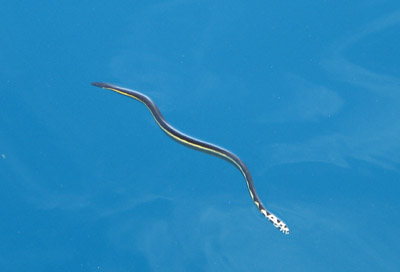Some Sea Snakes Can Go Seven Months Without Drinking Water
To survive the dry season, yellow-bellied sea snakes severely dehydrate until the wet season brings freshwater for them to lap up from the ocean’s surface
:focal(700x304:701x305)/https://tf-cmsv2-smithsonianmag-media.s3.amazonaws.com/filer/d7/4a/d74a64a3-0acc-4173-8d7f-7ff3850b402b/yellow.jpg)
Sea snakes—as their name implies—spend all of their time at sea. On land, these marine creatures are virtually helpless, unable to slither or move about. With their paddled tails, narrow heads and thin, fish-like bodies, a sea snake slinking through a coral reef could easily be mistaken for an eel.
Yet for all of their sea faring finesse, sea snakes—which evolved from terrestrial snakes—are not completely at home beneath the waves. For starters, like sea turtles and marine mammals, they do not have gills and so must regularly surface for air. And like other marine animals with terrestrial roots, including penguins and marine iguanas, sea snakes had to evolve ways to excrete excess salt, which they accomplish special salt-expelling glands around their tongue. Unlike animals like sea turtles, however, the sea snakes’ salt glands cannot handle the massive amounts of salt that would enter their bodies if they actually drank seawater.
This poses a serious problem when it comes to getting enough water to drink. If seawater is off limits, how do these animals survive in the ocean?
An international team of researchers decided to investigate this question by studying yellow-bellied sea snakes, which live in warm, open waters around the world. In a paper published in Proceedings of the Royal Society B, the team focused on a population of animals living near Costa Rica, where rain oftentimes does not fall for up to seven months out of the year. “Rainfall is more likely to occur over land, so the open ocean can be a virtual ‘desert’ especially during the dry season,” the researchers explain.

Because yellow-bellied sea snakes usually spend all of their time far from land, they continue, rain would be the animals’ only resource for fresh water. When it rains, a thin film of fresh water—which quickly mixes into brackish and then salt water—forms on top of the ocean, providing the snakes with a fleeting opportunity to lap up that precious resource. But during the dry season when there is no rain, snakes presumably have nothing to drink. “Thus, we became interested to test whether this pelagic vertebrate dehydrates at sea,” the team writes.
Over the course of 10 trips out to sea during both the wet and dry seasons, the researchers collected more than 500 yellow-bellied sea snakes. They measured the snakes and offered them fresh water to see how eager they were to drink (a proxy for dehydration), and weighed them both before and after release. They used those figures to approximate the snakes’ body condition—a measure of fat and muscles content—at capture. Additionally, they euthanized 40 snakes to determine their total body water by weighing them before and after completely drying them out in an oven.
The researchers found that during the dry season about half of the snakes accepted the freshwater offer, while nearly none drank during the wet season. A snake’s likelihood to drink also correlated with its body condition, with more withered snakes being more likely to drink, and to drink more. Finally, as predicted, snakes captured during the dry season contained significantly less body water than those scooped up in the rainy season.
Conceivably, some yellow-bellied sea snakes might go six or seven months without encountering any freshwater, the team writes, but they seem to be specially adapted to deal with this. The snakes’ total body water content—determined from the baked individuals—averages around 80 percent, which is pretty high compared to other reptiles, including snakes that live in freshwater (around 70 percent) and sea turtles (around 65 percent). Those extra water stores, the team thinks, might help the yellow-bellied sea snakes survive for long periods of drought by siphoning water from their in-house reserves. Some of the snakes they caught at the height of the dry season, for example, had lost up to 18 percent of their body mass due to lost water content, supporting this hypothesis.
Some recent studies have found “enigmatic declines” in sea snake populations over the past few years. Could this be because of fresh water shortages due to a changing climate? The researchers think maybe so, writing, “This information provides new insights for understanding water requirements of sea snakes, reasons for recent declines and extinctions of sea snakes and more accurate prediction for how changing patterns of precipitation might affect these and other secondarily marine vertebrates living in tropical oceans.”
/https://tf-cmsv2-smithsonianmag-media.s3.amazonaws.com/accounts/headshot/Rachel-Nuwer-240.jpg)
/https://tf-cmsv2-smithsonianmag-media.s3.amazonaws.com/accounts/headshot/Rachel-Nuwer-240.jpg)